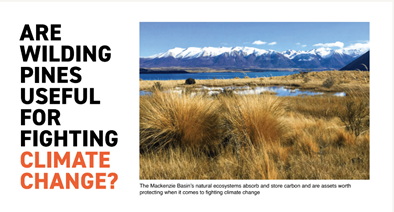Article: Are wilding pines useful for fighting climate change?
As trees grow, they absorb carbon from the atmosphere through photosynthesis to be stored in their trunks, branches, leaves, and roots, providing energy for themselves to continue to grow, while helping to reduce carbon dioxide levels and slowing down climate change. How great is that!
One of the main arguments for not removing wilding pines is that by simply existing they are absorbing carbon and helping to fight climate change. While it is true that all trees, including wildings, do sequester carbon, wilding trees are not a helpful tool when it comes to achieving climate change targets because their negative impacts far outweigh their carbon-absorbing benefit.
If we didn’t control wildings and allowed them to spread so that we could use them to sequester carbon, they would continue to invade and harm our native biodiversity and ecosystems, they would reduce the availability of productive land, increase the burning intensity and risk of serious damage from wildfires, and decrease water yields (Nunez, et al., 2021). The Ministry for Primary Industries states that wilding pine infestation is not a beneficial long term land use, and this is acknowledged globally in climate change policy. Wilding trees cannot be used in international carbon accounting to offset emissions, and they cannot be entered into the New Zealand Emissions Trading Scheme (Ministry for Primary Industries, 2021).
While there is no doubt that trees are a fantastic resource for helping to mitigate carbon emissions, some types of trees, forests and ecosystems are better at it than others, and all have different impacts on their surrounding environments. It is important to have the right type of tree in the right place. Better ways of sequestering and storing carbon include plantation forestry and native ecosystem restoration.
There are several reasons why plantation forestry is a better way to fight climate change than allowing the spread of wilding pines. While plantation forestry and wilding tree invasion both provide rapid carbon absorption by consisting of fast-growing tree species, plantation forestry, unlike wilding tree invasion, also provides a profitable resource upon maturity of the forest when it is harvested and turned into timber, pulp, chip, or used as biofuel or other materials. When the wood is manufactured into useable items, like furniture for example, the carbon remains stored in the wood for as long as the item exists, which tends to be much longer than if the trees were burned or left to rot into the ground. Plantation forests also provide long term employment and contribute to a strong and healthy economy.
The other essential tool in the fight against climate change is the restoration and recovery of degraded existing native forests and ecosystems. Old growth temperate forests such as the forests of South Westland here in New Zealand, and similar forests in Chile, Tasmania, South East Australia and North West North America have a much greater biomass than plantation forestry and are among the world's densest natural carbon stores (Goldstein, et al., 2020). This means the combination of trunks, vines, leaves, mosses, and other plant matter within the forests have more density per hectare than plantation forestry, or wilding pines, and are therefore able to hold on to more carbon.
An important point to make here is that existing native forests and ecosystems tend to be in more of a mature phase rather than a growth phase and are therefore more affective at holding onto carbon that has already been absorbed, rather than rapidly sequestering new carbon from the atmosphere. However, a recent report by Forest and Bird (Forest and Bird, 2021) suggests that a degree of new sequestration can still be achieved. If feral browsing pests such as possums, deer, wallabies, goats, pigs, chamois, and tahr were able to be controlled to the lowest possible levels the carbon sequestration of New Zealand’s native ecosystems could increase by 8.4 million tonnes of CO2 per year. This is equivalent to nearly 15% of New Zealand’s 2018 net greenhouse gas emissions. Protection of existing native forests and ecosystems then becomes not only about preventing the release of huge amounts of stored carbon, more than could be recovered in the timeframes required to avoid catastrophic global warming, but also about maximising carbon absorbing potential where possible to complement that of plantation forestry.
It is important also to remember that all plants and ecosystems store carbon, not just trees and forests. Regarding the Mackenzie Basin this includes the indigenous tussock grasslands, shrublands and wetlands that exist here. These ecosystems all absorb and store carbon and are all assets worth protecting when it comes to fighting climate change. Alongside their ability to sequester carbon these ecosystems also provide for natural functions and conditions to support native biodiversity, water availability, water filtration and natural pollination, as well as cultural, recreation and tourism values. These are all factors that contribute positively to a healthy, functioning community and a strong local economy (Ecosystem services in New Zealand, 2013).
We at Wilding Free Mackenzie believe a better way to fight climate change is not to allow wilding pines to spread, but to protect and restore the native biodiversity, ecosystems and natural carbon sinks we still have around us, to support best-practice management of plantation forestry, and to consider making changes to our own lifestyles to reduce our own carbon emissions.
Posted: Fri 10 Sep 2021
| Top |

